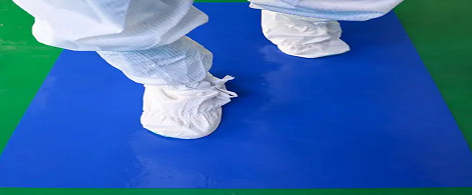Cat:Glue -coated Protective Film
One single flaw is enough to change a “superior” product to “inferior”and thus perfect products need good protection. How you protect your valuable ca...
See Details
In modern industrial and research fields, maintaining a cleanroom environment is crucial. Dust, particles, and contaminants not only affect product quality but can also cause equipment failures or experimental errors. Controlling dust sources is a key step in preserving cleanroom standards. Among the most direct and effective tools for this purpose is the Sticky Mat. Widely used at cleanroom entrances, exits, and buffer zones, it helps efficiently remove dust from shoes and wheels, ensuring the quality of the controlled environment.
A Sticky Mat, also known as a tacky mat or clean room mat, is a mat with a high-adhesive surface designed to capture dust, particles, and contaminants from shoes and wheels. Its main purpose is to prevent dust from entering the cleanroom or controlled environment.
The primary functions of a Sticky Mat include:
Sticky Mats are commonly used in:
The adhesive level and material of a Sticky Mat directly affect its dust removal efficiency. Generally, adhesive levels are categorized as light, medium, and heavy:
When choosing a Sticky Mat, consider the following:
The specifications of Sticky Mats should vary depending on the area. Entrance areas require full coverage, while buffer zones can use smaller or segmented mats. This ensures maximum dust removal efficiency.
Sticky Mats should be placed at all key entry and exit points where personnel or equipment pass through. The optimal setup is one mat inside and one outside the door, forming a double barrier against dust.
When using a Sticky Mat, walk or push equipment steadily to avoid scattering dust. Personnel should pause briefly on the mat to allow shoes and wheels to release dust fully.
Sticky mats should be replaced when the surface becomes covered with dust or the adhesive diminishes. Overusing a mat can result in dust re-entering the clean area and reduce effectiveness.
Multi-layer Sticky Mats allow the top layer to be peeled off when soiled, instantly restoring dust removal effectiveness. It is recommended to replace the top layer weekly or based on dust levels in the workspace.
Use a dust-free mop or vacuum cleaner regularly around the Sticky Mat to prevent dust buildup from affecting the cleanroom.
In actual cleanroom operations, the placement and use of Sticky Mats directly affect dust control effectiveness. The table below shows the practical performance of different mats in various areas:
| Area | Mat Type | Usage Frequency | Dust Removal Effectiveness |
|---|---|---|---|
| Cleanroom Entrance | High-adhesive multi-layer | Replace top layer daily | 95% dust removal rate |
| Buffer Zone | Medium-adhesive single-layer | Replace weekly | 85% dust removal rate |
| Equipment Passage | Medium-adhesive multi-layer | Daily inspection and replace necessary layers | 90% dust removal rate |